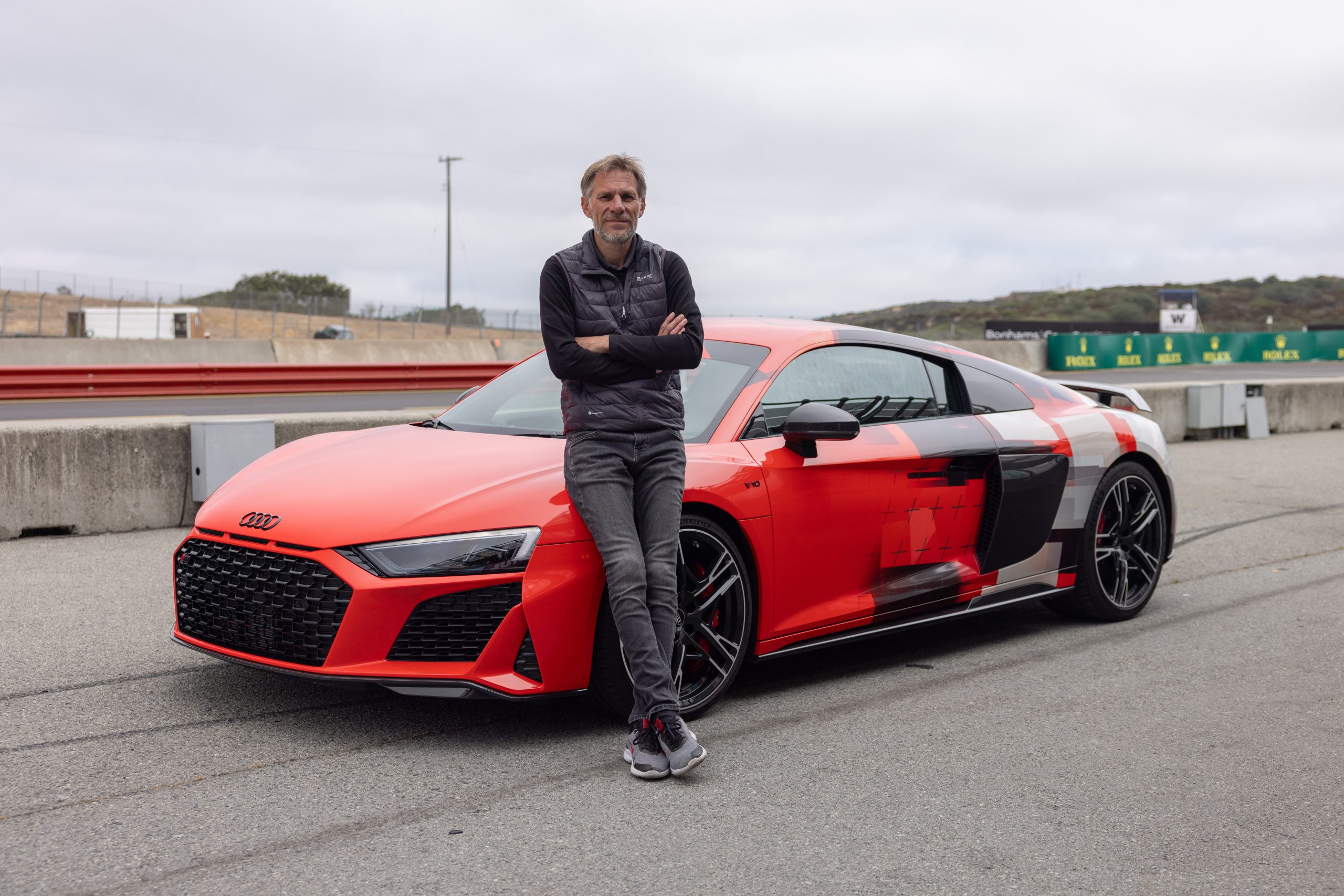Audi R8’s Last Laps - 5 minutes read

Audi R8’s Last Laps
As the icon makes an outro during Monterey Car Week we talk to its exterior designer, Frank Lamberty
Frank Lamberty, courtesy of Audi
What do a vintage Porsche race car, a late ’90s Ducati sport bike, an eagle and a tennis ball have in common? They all served as inspiration for the exterior design of the original Audi R8.
We were fortunate enough to be guided through the story of Audi’s first super sports car by none other than the man who penned the exterior, Frank Lamberty. As he explains it, “there had never been a concept like this in the brand’s history; there were no role models.” With that mind it’s a little easier to imagine how the aforementioned influences came into play, it was truly a clean sheet design opportunity.
When designing a car there are only two forms to begin with—one with edges, one with no edges.Frank Lamberty
When staring at the front end of the LeMans quattro concept car that preceded the production ready R8, it quickly becomes apparent where the eagle factors in. As for the Porsche 904 and Ducati 996, one only needs to briefly view the R8 in profile to see where those had an impact. But what about the tennis ball? Lamberty told us that “when designing a car there are only two forms to begin with—one with edges, one with no edges. A rectangle and a circle. The rectangle can be refined, shaving away from it creates the shape. However the circle is manipulated, squished and pulled until a shape is found, this is a more fluid shape.” Taking that into consideration it’s then easy to see how the highly technical R8 owes some part of its existence to the simple tennis ball.
Courtesy of Audi
From Lamberty’s original 1999 design competition sketch to the 2003 LeMans quattro concept and ultimately the first generation R8, the design is perfectly balanced. Especially in a sports car, “proportions count,” says Lamberty. “A mid-engine sports car is something very special, again because the technical layout, the position of the engine results in a completely different design language.” Driving home that point was quite important to Lamberty and after much back and forth, one of the most iconic automotive design elements of the modern era, perhaps in automotive history, made it through to production, the sideblades. In Lamberty’s own words, “A very important element in the design of the R8 are the sideblades. In front of them is the cockpit, and after that comes the technology. The sideblade, as the air control element that feeds air to the engine, connects these sections of the vehicle. All of the R8’s lines follow this one incredible logic, because for this model, it was important to find its own design key.” And find its own design key it did.
Courtesy of Audi
The LeMans quattro concept arrived at IIA in Frankfurt in 2003 and was an immediate sensation. With Audi being three years into what would end up being a dominant run at LeMans, taking five titles in six years with Tom Kristensen behind the wheel of the R8 LMP race car, the timing for a super sports car concept couldn’t have been better. Three years later a production ready car bearing the R8 name debuted at the Paris Motor Show and was again an immediate sensation. The 2007 R8 quickly sold out in Germany and demand for the hand-built super car around the world would only intensify in the years to follow thanks in part to watershed moments like the classic Super Bowl “godfather” commercial and integration into the first Iron Man film.
Courtesy of Audi
Concluding its 15 year production run after two generations and countless special variants, not to mention the stunning Spyder models, the importance of the R8, both to Audi and to automotive enthusiasts cannot be overstated. Whether in motorsport competition, where the R8 GT3 has won every major endurance race, including the Daytona 24hrs twice and Nurburgring 24hrs six times, or in the enthusiast community, where the first-generation R8, with its gated six-speed manual transmission and optional V10, is one of the few true “poster cars” to come along since the turn of the millennium, the R8 has captured hearts and minds the world over. With Audi sharing that they’re committed to introducing more than 20 new models globally by 2026, and adding only fully electric models from there onward as they head toward a fully electric product portfolio by 2033, it’s come time to bid farewell to the naturally aspirated 5.2L V10 and the R8 as we know it.
Courtesy of Audi
While it’s no doubt a bittersweet moment, we’re glad to have had the chance to join the kickoff of the goodbye tour in grand style, behind the wheel of a 2023 R8 V10 performance Coupe RWD on the famed Laguna Seca Raceway. The sense of occasion was further heightened by a unique exterior wrap inspired by the R8’s “born on the track and built for the road” ethos and designed by none other than Lamberty himself. After two pulse quickening, “straight-out-of-a-dream” laps following Kristensen around Laguna Seca, saying farewell to the naturally aspirated R8 and the soul stirring sound that goes with it felt even more bittersweet than before. However, one quote that was shared with us from Audi’s Head of Design, Marc Lichte, left us feeling optimistic as we walked away from the experience. “I promise you, both EVs and ICE will be impressive. Especially the last-generation ICE RS models. They will be… mind-blowing.”
Audi R8’s Last Laps
AD SLOT: article_design_incontent AD SLOTCONTEXT: incontent
This placeholder is removed when the ad slot is configured.
Source: Cool Hunting
Powered by NewsAPI.org